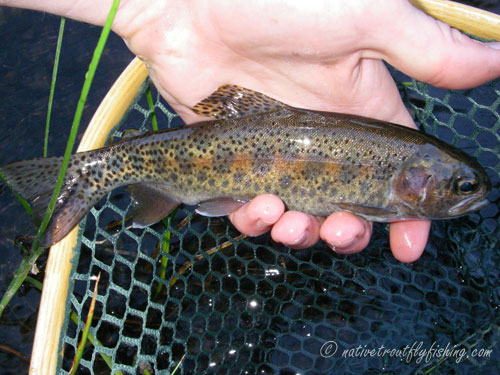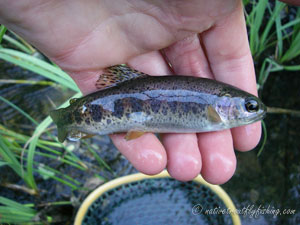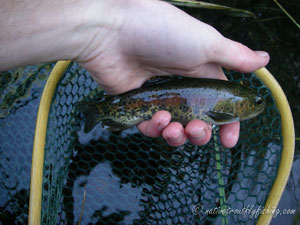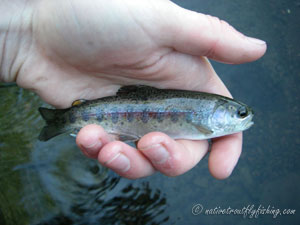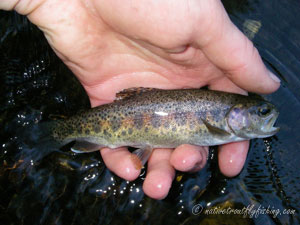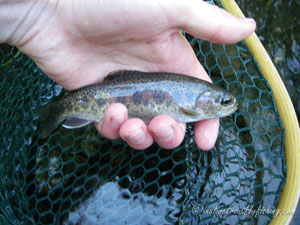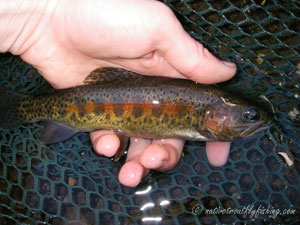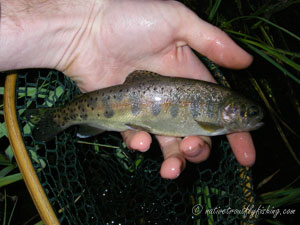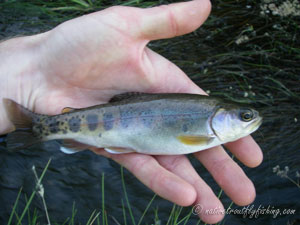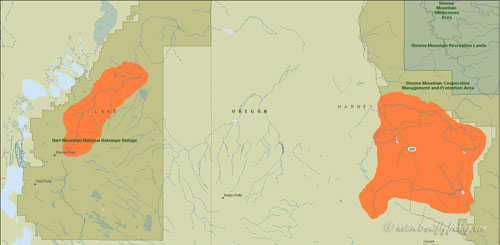Catlow Valley Redband
Oncorhynchus mykiss gairdneri
A Catlow Valley Redband from an eastern Oregon desert stream
Introduction
The Catlow Valley Redband Trout are native to the streams of the Catlow Basin in Southeastern Oregon, including Rock, Home, Skull and Threemile Creeks. These fish are thought to be most closely related to Harney-Malheur Basin and Columbia Basin Redband (Behnke 2002, Behnke 2007, Currens et al. 2009, Dehaan et al. 2015).
Life History Information
During the cooler climate period of the Pleistocene Era, the Catlow Valley was filled with a large lake and under these conditions the fish adapted to an adfluvial life history. However, as the climate warmed the basin's lake desiccated and the fish were isolated in streams on the east and west sides of the basin. In recent times, these Redbands had the ability to express migratory and even lacustrine life history types in the Catlow Marsh (Garrison Lake). However, this life history type was lost when the Catlow Marsh was drained for agricultural proposes. Currently the ability to express an adfluvial life history only occurs during wet years when Redbands are able to utilize the reservoirs on Rock, Skull and Threemile Creeks (ODFW 2005). When it is available, this adfluvial life history type provides an important contribution to the continued survival of these populations as the reservoir dwelling females can contribute up to five times as many eggs as their stream resident counter parts (Kunkel 1976). However, on Rock Creek, even when the reservoir is available as habitat, it is uncertain whether the Redbands have the ability to return upstream to suitable spawning habitat (Bowers et. al 1999). As such today the only suitable habitat for trout in the Catlow Valley is generally restricted to the upper reaches four small streams, and as a result these fish exhibit stream resident life history styles. The habitat in these streams is extremely unstable with rapid fluctuations in temperature. Under these conditions Catlow Valley Redband Trout have gained a genetic tolerance for high temperatures and have been shown to be able to withstand higher water temperatures than any other type of Rainbow Trout (Behnke 2002, Rodnick et al. 2004). Even with this adaptation though, the most suitable trout habitat in the valley is restricted to stream stretches with the presence of springs or canyons, habitat which provides important refuges during the warm conditions found in summer (ODFW 2005).
Status
In 1997 there was a petition to list the Redbands of the desert basins of Oregon including the Catlow Basin Redband under the Endangered Species Act (ESA) (USFWS 1997). This petition was denied but has resulted in increased protection and monitoring for the Redbands. In a 2005 status review of their state's endemic fish, the Oregon Department of Fish and Wildlife labeled the Catlow Valley Redbands as being at risk of extinction (ODFW 2005). During this study the state identified five distinct populations of Redbands, which included one that was said to be extinct in Guano Creek. According to Behnke (2007) though, Guano Creek is at a higher altitude and isolated from other streams in the Catlow Valley, so it likely did not contain any native Redband Trout. Of the other streams mentioned, three were found to be depressed and actions to restore degraded habitat along these creeks are being undertaken. Rock Creek one the has been noted as having some of the highest densities of Redbands in the Great Basin, likely due to thermal springs, which cause the stream to be highly productive (Dambacher et al. 2009). The major causes of the decline these fish in the native streams has been from habitat alterations. This includes the loss of riparian vegetation and erosion due overgrazing and dewatering of habitat for agricultural purposes.
Description
The coloration of these fish is olive or bronze on the back and transitions to brassy-yellow across the body. These Redbands have a pink to brick red stripe along their lateral line, and the same coloration on their gill plates. The spotting pattern consists of small to medium round or irregular shaped spots that are profusely distributed above and slightly below the lateral line, and on the caudal and dorsal fins. The caudal fin is forked, dorsal fin may be tipped with either white or orange, and anal and pelvic fins are tipped with white. Parr marks are purplish in coloration and are generally retained into maturity.
Stream Resident Form
Click on images to view a larger picture
Native Range
A map of the native range of the Catlow Valley redband trout. Data Sources: Behnke (2002) and ODFW (2005).
References
Behnke, R. 2002. Trout and Salmon of North America. Chanticleer Press, New York.
Behnke, R.J. 2007. Redband trout of the Northern Great Basin. Pages 1–9 in R. K. Schroeder and J.D. Hall, editors. Redband trout: resilience and challenge in a changing landscape. Oregon Chapter, American Fisheries Society, Corvallis.
Bowers, W., Smith, R., Messmer, R., Edwards, C., and Perkins, R. 1999. Conservation status of Oregon Basin Redband Trout, Oregon Dept. of Fish and Wildlife, Hines, OR.
Currens, K.P., C.B. Schreck and H.W. Li. 2009. Evolutionary ecology of redband trout. Transactions of the American Fisheries Society 138: 797–817.ODFW. 2005. Oregon native fish status report. Oregon Dept. of Fish and Wildlife, Salem, OR.
Dambacher, J.M., K.K. Jones and D.P. Larsen. 2009. Landscape-level sampling for status review of Great Basin Redband Trout. North American Journal of Fisheries Management 29:1091–1105.
DeHaan, P., J. Von Bargen, M. Meeuwig and S. Clements. 2015. Great Basin redband trout genetic status assessment. United States Fish and Wildlife Service. Longview, Washington.
Kunkel, C. 1976. Biology and production of the Red-band Trout (Salmo sp.) in four southeastern Oregon streams. Masters of Science Thesis. Oregon State University. Corvallis, OR.
ODFW. 2005. Oregon native fish status report. Oregon Dept. of Fish and Wildlife, Salem, Oregon.
Rodnick, K.J., Gamperl, A.K., Lizars, K.R., Bennett, M.T., Rausch, R.N., and Keeley, E.R. 2004. Thermal tolerance and metabolic physiology among redband trout populations in south-eastern Oregon. Journal of Fish Biology 64: 310-335.
U.S. Fish and Wildlife Service (USFWS). 1997. A petition for rules to list great basin redband trout (Oncorhynchus mykiss ssp) as threatened or endangered under the Endangered Species Act. Oregon Natural Desert Association, Portland, OR.
Contact
Feel free to contact me if you have any questions or comments
Catlow Valley Redband Trout Links
My Catlow Valley Redband Trips
Oregon Department of Fish and Wildlife - Redband Trout Angling
Western Native Trout Initiative - Redband Trout
Native Trout Links
Truchas Mexicanas' - Native Trout of Mexico
Balkan Trout Restoration Group
Trout and Seasons of the Mountain Village - About Japanese Trout
Western Native Trout Challenge
California Heritage Trout Challenge
Fly Fishing Blogs
Dave B's Blog: Fly Fishing for Native Trout
The Search for Native Salmonids
Conservation Links
Western Native Trout Initiative
Fly Fishing Links
Fishing Art Links
Americanfishes.com - Joseph R. Tomelleri
